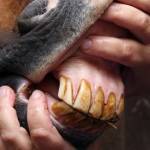Checking for Dehydration in Horses

Horses that are exercised during hot, humid weather lose fluid and electrolytes as they sweat. In very hot weather, even a fairly short exercise period can result in a significant fluid loss. Dehydration makes the horse’s heart work harder and disrupts nerve and muscle action. In serious cases, it can lead to colic, kidney failure, and even death.
Avoiding dehydration is a much safer plan than trying to resolve this dangerous occurrence. During extreme summer weather, riders should try to exercise horses early in the morning and should cut back on the duration and level of performance. Horses should be cooled after exercise by hosing or sponging with cold water, and should always have free access to water in stalls or pastures. Giving an electrolyte paste or powder formulated to replace the substances lost in sweat will help horses recover more quickly after strenuous exercise.
Restore Paste, developed by Kentucky Equine Research (KER) and available in the U.S., Australia, and many other countries, stimulates thirst response and encourages horses to drink while supplying sodium, chloride, magnesium, and potassium. The paste is an easy-to-administer product that includes a buffering agent designed to support gastrointestinal comfort in horses.
It may take several hours or even a day or more for a heavily sweating horse to rehydrate completely. During this time, owners can use a couple of tests to get a general idea of the horse’s status. The skin pinch and the capillary refill can both indicate whether a horse is adequately hydrated. Horse owners should practice these tests and become familiar with the result when their horses are in good condition.
As the horse loses water through sweating, its skin becomes less elastic. An owner can grasp a fold of skin on the horse’s shoulder and pull it gently up into a slightly raised tent-like shape. In a horse that is somewhat dehydrated, the tented skin will remain raised for a couple of seconds before flattening out. If the horse’s skin stays tented up for four or five seconds or longer, this can be a sign of serious dehydration. This test is not completely reliable, and results will be different between horses, but an owner familiar with a particular animal’s normal state will be able to learn something from this test.
Capillary refill is another way to check hydration status. To do this test, the owner begins by pushing the horse’s upper lip back to expose the upper gums. The gum tissue should be pink and moist, not too pale and definitely not a dark brick-red, blue, or purple color. Pushing a thumb against a section of gum and then removing the pressure will reveal a pale spot where the blood has been squeezed out of the capillaries. If a horse is properly hydrated, the small blood vessels will refill quickly, usually within a second or two. Anything longer than this is a sign that the horse has lost a lot of fluid or is possibly going into shock. Horses that don’t seem to be recovering from hard exercise and show signs of dehydration that do not resolve quickly should be examined by a veterinarian.








